Author: Zeng Lu
How has international aid supported Palestinian development during the decades of Palestinian-Israeli conflict? After the outbreak of the Palestinian-Israeli conflict, how did the major donor countries respond?
On October 6, Palestinian Hamas militants broke through the separation wall and launched an attack in Israel, killing at least 1,200 Israelis and taking more than 200 people hostage. Three days later, Israel began air, sea and land attacks on the Gaza Strip while preparing for a ground offensive. Israeli forces say they are targeting Hamas and not civilians.
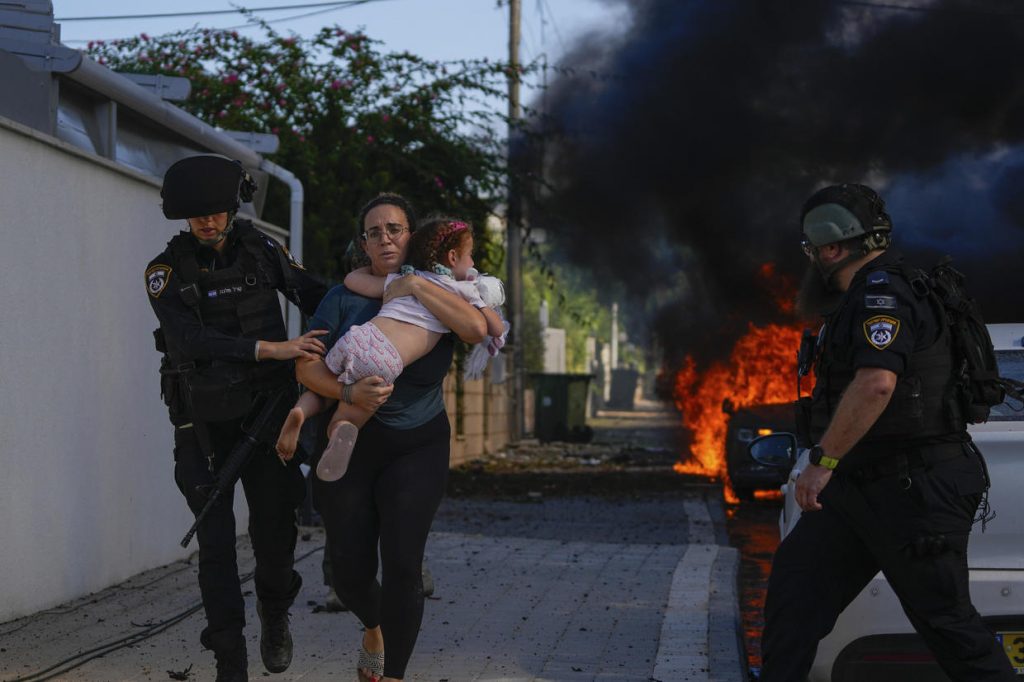
(AP/Picture: Israeli police evacuate civilians affected by rockets in Gaza)
As of October 21, the Palestinian side stated that more than 4,000 Palestinians had been killed in attacks, including more than 1,500 children. The Office of the United Nations High Commissioner for Human Rights (OHCHR) stated that at least 11 journalists, 28 medical staff and 14 United Nations staff were killed in the attack in the Gaza Strip. The United Nations Office for the Coordination of Humanitarian Affairs (UNOCHA) said that about 1 million people, accounting for nearly half of Gaza's total population, have been displaced since the conflict began.
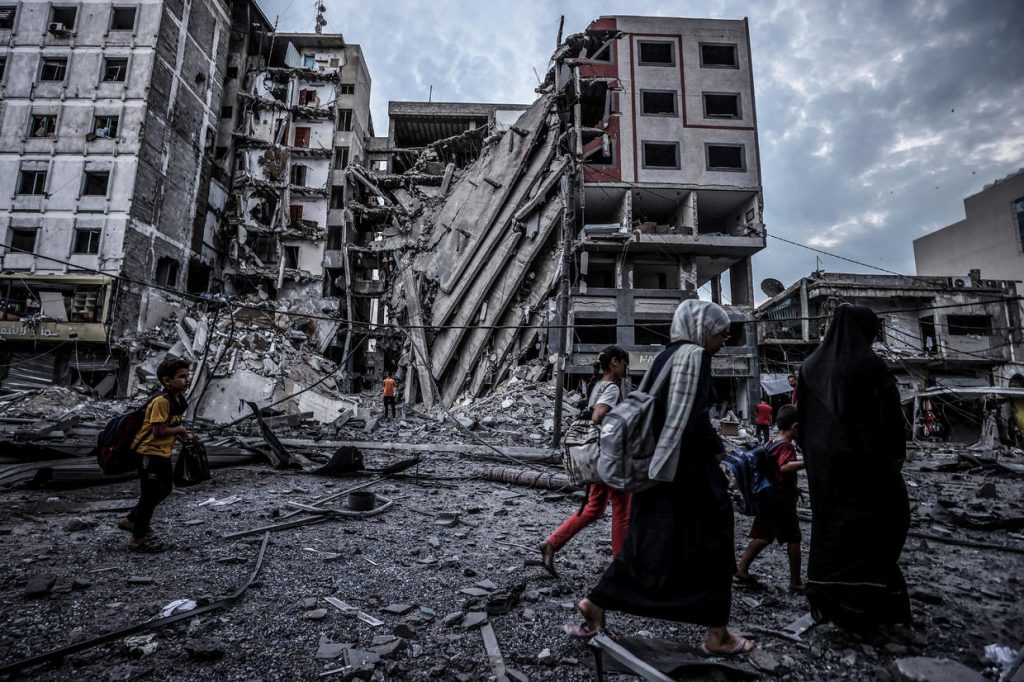
(GETTY IMAGES/Photo: Israeli air strikes on the Islamic State Bank building in Gaza)
Palestine: West Bank and Gaza
Palestine includes the West Bank and Gaza Strip.The West Bank is run by the Palestine Liberation Organization, which recognizes Israel and is seen by most countries as the legitimate representative of the Palestinians. In 2007, the radical Islamic organization Hamas won the Palestinian parliamentary election and has long controlled Gaza. Hamas rejects the Israeli peace process and is committed to destroying Israel. The United States, the European Union and other countries and international organizations have designated Hamas as a terrorist organization. Israel has imposed a blockade on the Gaza Strip since 2007, and neighboring Egypt has severely restricted movement through the Rafah crossing. The Gaza Strip has been blockaded and isolated from the world for more than 16 years now.
| Israeli restrictions and blockades severely impact Palestinian development |
|
Israel stationed the Israel Defense Forces (IDF) in the Palestinian territories of the West Bank, set up a "separation wall", established Israeli settlements, exercised administrative control, and issued and executed military orders, which seriously affected the daily life of Palestinians in the West Bank. Since 2007, Israel has blocked the Gaza Strip to prevent weapons, ammunition and militants from entering Gaza in order to reduce attacks and conflicts in Israel and exert economic and political pressure on the Gaza Strip. Israel has closed the Erez crossing to allow only specific persons to pass; it has blocked the maritime borders of the Gaza Strip and restricted the entry and exit of ships; it has blocked the airspace of the Gaza Strip and only allows entry by Israeli government or specifically authorized aircraft; and it has strictly controlled the import and export of materials in the Gaza Strip. These restrictions and blockades have resulted in Palestinian material shortages, declining employment rates, and deteriorating infrastructure conditions. United Nations Security Council Resolution 2334 condemned Israel’s settlement establishment in the West Bank and East Jerusalem and demanded an immediate halt to all settlement expansion activities. A 2020 United Nations report stated that Israel's blockade has caused economic losses of up to $1.6 billion in Gaza and caused poverty and unemployment to soar. The United Nations calls on Israel to lift the blockade. |
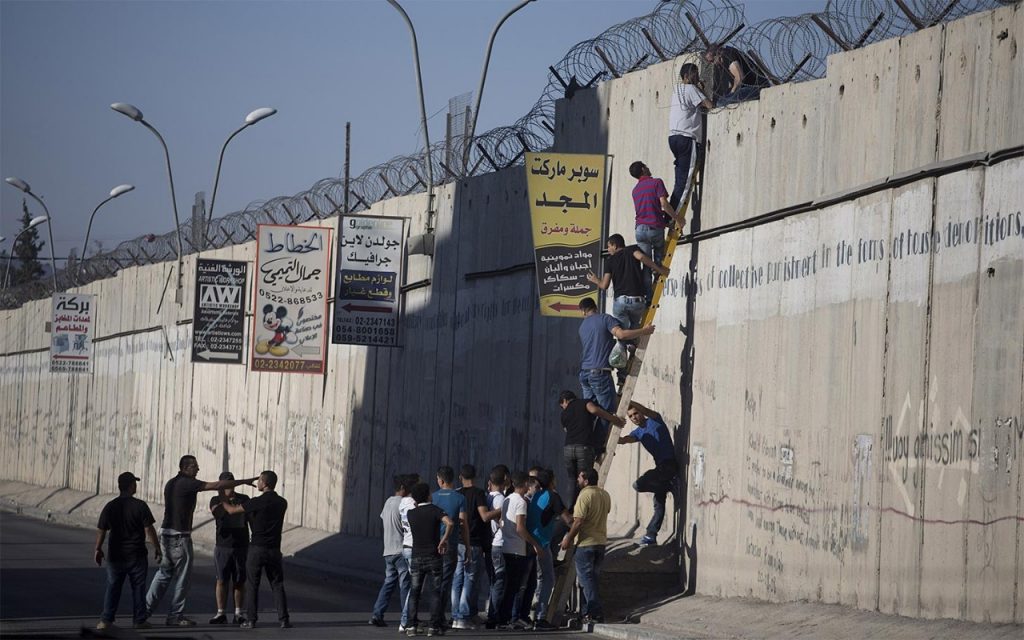
(AI Jazeera/Photo: West Bank Separation Wall)
“Palestine” versus “West Bank and Gaza.”Different countries and international organizations refer to Palestine by different names based on different political views, laws, positions or diplomatic considerations. Some countries recognize Palestine as an independent state and refer to the West Bank and Gaza Strip as "Palestinian territories." Other countries and international organizations use "West Bank and Gaza", "occupied territories" or "disputed territories" to refer to Palestine. The name used by a country or international body to refer to the State of Palestine does not necessarily reflect its recognition or denial of Palestine's status, but rather its stance on the Israeli-Palestinian conflict and its diplomatic relations with the parties involved.
Palestine faces serious development and humanitarian challenges
International aid has had limited effectiveness over the past few decades.Over the past few decades, international organizations and donor countries have provided substantial development and humanitarian assistance to Palestine, and living conditions and infrastructure in the West Bank have improved significantly. The once bumpy dirt road became smoother. The standard vaccination rate for children is close to 100%. School attendance and literacy rates for boys and girls are at record levels. However, ongoing political challenges, limited resources and coordination difficulties have resulted in Palestinian development struggling.
Key statistics for the occupied Palestinian territory
|
index |
west bank |
Gaza Strip |
total |
|
population |
3,154,418 |
2,136,507 |
5,290,925 |
|
Area(km2) |
5,655 |
365 |
6,020 |
|
GDP per capita |
4,197 |
1,208 |
2,923 |
|
poverty rate |
13.90% |
53.00% |
29.20% |
|
Male labor force participation rate |
73.60% |
61.20% |
68.90% |
|
female labor force participation rate |
1 7.2% |
17.30% |
17.20% |
|
youth labor force participation rate |
31.70% |
24.50% |
28.80% |
|
male unemployment rate |
12.40% |
41.90% |
22.40% |
|
female unemployment rate |
28.90% |
65.00% |
42.90% |
|
Youth unemployment rate (15-24 years old) |
27.80% |
68.90% |
41.70% |
|
Number of doctors per 1,000 residents |
3.25 |
2.71 |
3.03 |
|
Number of nurses per 1,000 residents |
3.61 |
5.64 |
4.43 |
|
Number of teachers per 1,000 residents |
12.31 |
10.2 |
11.46 |
|
Proportion of population under 29 years old (%) |
64% |
69% |
66% |
|
Proportion of refugee population (%) |
26.30% |
66.10% |
42.20% |
|
annual population growth rate |
2.20% |
2.90% |
2.50% |
|
Food insecurity rate (%) |
8.90% |
64.4% |
31.20% |
Data source: United Nations (November 2022), Palestinian Central Bureau of Statistics. West Bank population data include East Jerusalem; other data exclude East Jerusalem. Poverty data are the latest official statistics in 2017; other data are from 2020 or 2021.
The blockade of Gaza has worsened economic conditions.In 2022, the Palestinian population is 5.4 million, of which 3.19 million are in the West Bank, with a low population density. Gaza has a population of 2.17 million, with an average population density of about 5,500 people per square kilometer, making it one of the most densely populated areas in the world. Israel controls more than 60% of land in the West Bank and has continued to blockade Gaza since 2007, resulting in restricted development in the West Bank, economic isolation in Gaza, and sharp deterioration in living conditions. Poverty, unemployment and food insecurity have left people in dire straits, exacerbated by rising food and gasoline prices caused by the Russia-Ukraine conflict. As of the end of 2022, the Palestinian unemployment rate was 24.4%, two percentage points lower than the previous year. Among them, the unemployment rate in the West Bank is 13.1%, and the unemployment rate in Gaza is as high as 45.3%. 36% of the Palestinian population lives below the poverty line.
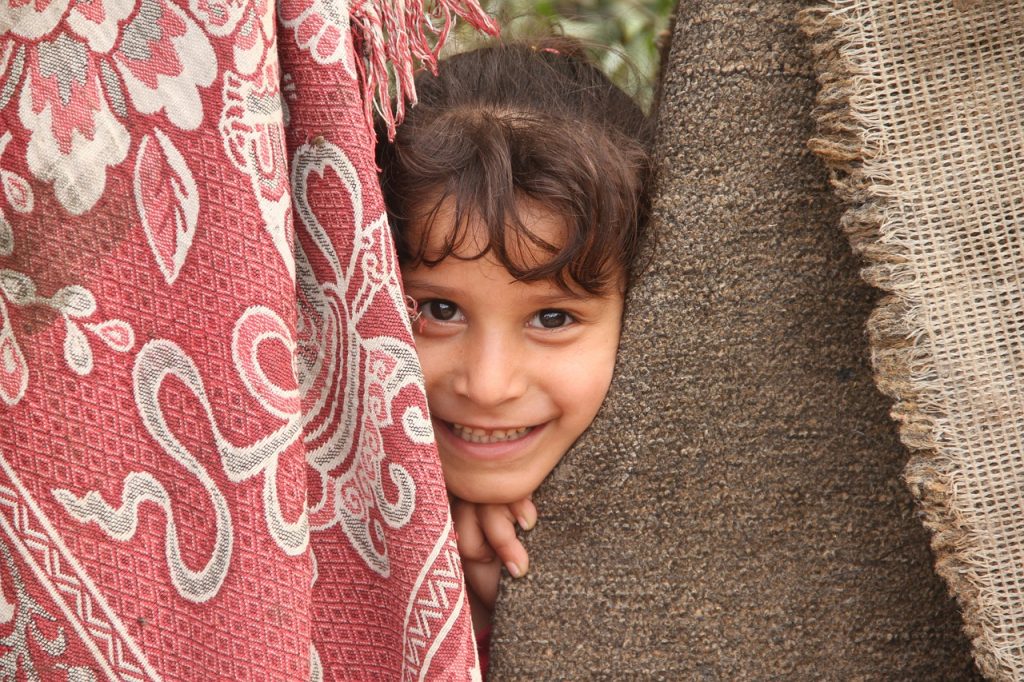
(Pixabay/Image)
Infrastructure faces huge challenges.Financial constraints, political instability, Israeli restrictions and blockades have resulted in Palestinian difficulties in accessing basic resources such as water, energy and land, as well as significant challenges in planning, developing and maintaining infrastructure. Water resources are limited in the West Bank and Gaza, wastewater treatment facilities are inadequate, and most of Gaza's population lacks clean drinking water. Palestine faces electricity shortages and relies on Israel, local power plants and private generators for power supplies. Gaza is suffering from blackouts, with only a few hours of electricity available each day. In addition, Palestine faces huge challenges in terms of infrastructure such as communications and technology, roads and public transportation systems.
Social development and humanitarian needs depend on international assistance.Only one third of Palestinian children have access to social protection programs, and child health and nutrition indicators continue to deteriorate. The situation is particularly difficult for the many refugees who still live in camps and are completely dependent on aid deliveries. Conflicts break out frequently, medicines are in acute shortage, and the health care system relies on international aid and is particularly overwhelmed by military conflicts with Israel. Approximately 2.1 million people in Palestine are in need of humanitarian assistance, and the number of people in the Gaza Strip who rely on international assistance is as high as approximately 80%.
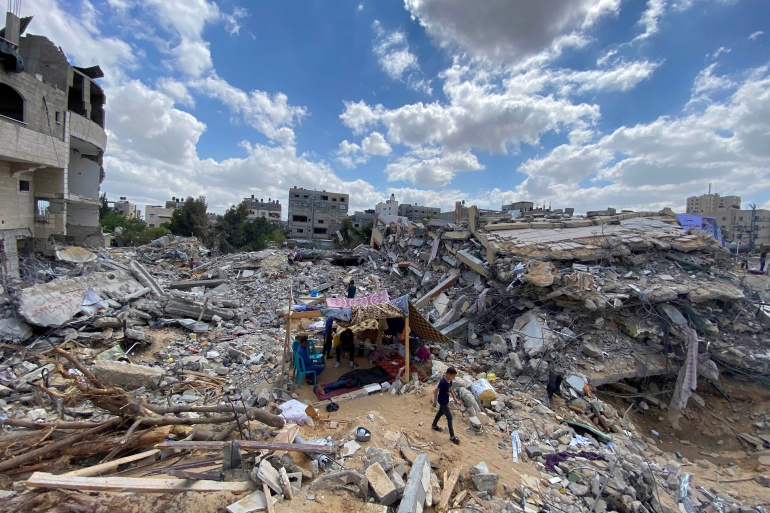
(CSS Point/Picture)
The refugee issue remained unresolved for seventy-five years.After the first Middle East war in 1948, hundreds of thousands of Palestinian refugees were forced to leave their homes. To this day, the Palestinian refugee crisis is the longest-running and still unresolved refugee problem in the world. In May 2023, the United Nations convened a high-level meeting to commemorate the seventy-fifth anniversary of more than 700,000 Palestinians becoming refugees from the land that later became Israel. In 1950, UNRWA served 700,000 Palestinian refugees. Today, approximately 5.9 million Palestinian refugees are eligible for UNRWA services.
Palestine has long received extensive assistance from the international community
From 1994 to 2020, the total aid flow to Palestine exceeded 40 billion US dollars, mainly (35.4%) used to support the budget of the Palestinian Authority (PA), and the remainder used to support Palestinian social services and economic sector development. The European Union, the United States, Saudi Arabia, Germany, etc. are among the countries and organizations that provide the most assistance to Palestine.
Bilateral official development assistance to Palestine from major donor countries
(2011-2021)
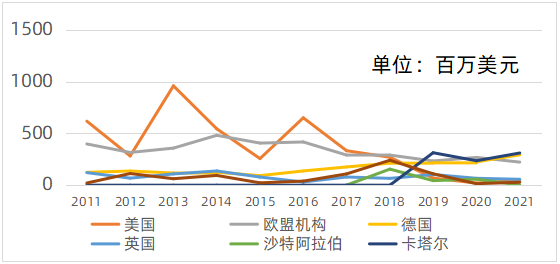
Source: Author based on OECD data. Data for Saudi Arabia from 2011 to 2018 are missing.
Total aid received by the West Bank and Gaza (1993-2021)
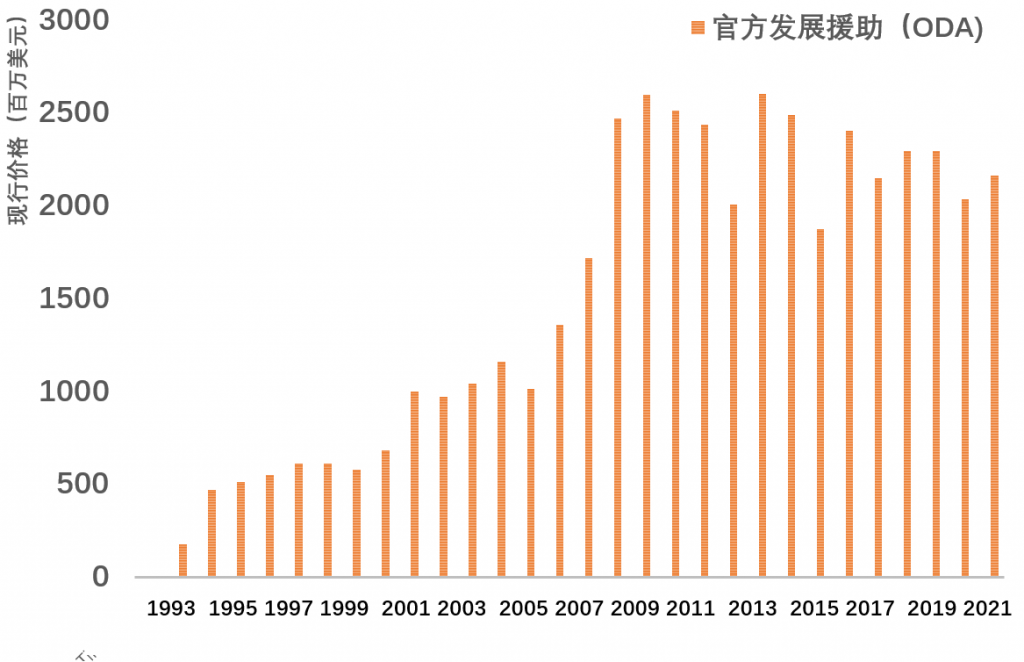
Source: Author based on OECD data.
U.S. supports improving lives for Palestinians
From 1950 to 1994, the United States provided assistance to Palestine mainly through the United Nations Relief and Works Agency. Since 1994, the United States has provided more than $5 billion in assistance to the United Nations Relief and Works Agency in the East. In the mid-1990s, the United States began providing bilateral assistance to the Palestinians, primarily through the United States Agency for International Development (USAID).
USAID's assistance to the West Bank and Gaza is dedicated to "improving the lives of the Palestinian people and creating conditions for a viable two-state solution." USAID’s Economic Recovery and Growth Program works to boost productivity, create an environment that attracts investment, and support Palestinian businesses’ entry into markets. The Youth Empowerment Project supports young people to build skills, generate income and increase community involvement. The Democracy and Governance Project supports civil society organizations in implementing social and community development projects, expanding their critical role in community development and conflict mitigation in the West Bank and Gaza. Water and sanitation projects support local residents' access to clean water and safe drinking water, and strengthen wastewater management to improve the environment, health and quality of life of residents in vulnerable communities. The Vulnerable Groups Project supports the non-food emergency needs of the most vulnerable groups in the West Bank and Gaza, such as food aid, hygiene products and medical supplies. Humanitarian programs provide life-saving humanitarian assistance, including food stamps, essential medical supplies, primary health and psychological support services, hospital public health training, child protective services and more. USAID also supports the global vaccine initiative COVAX to provide more than 1 million doses of COVID-19 vaccines to the West Bank and Gaza.
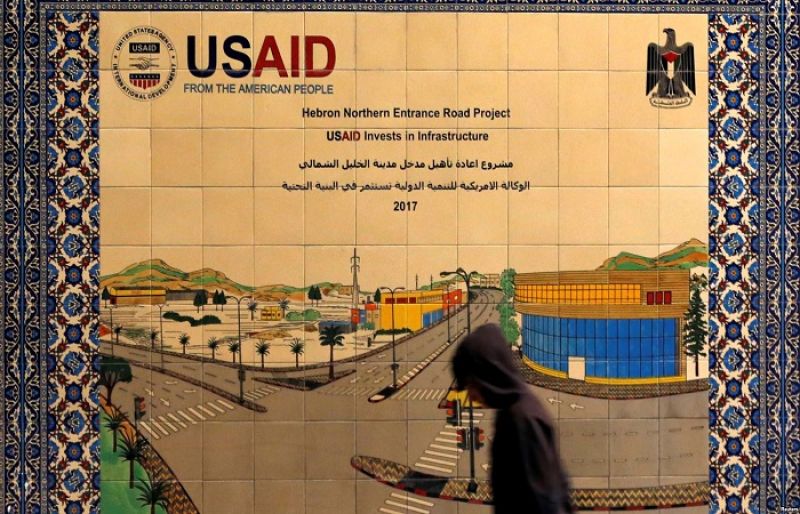
(SuchTV/Photo)
From 1994 to 2021, the United States provided more than $5.7 billion in aid to Palestine. From September 2021 to 2024, USAID expects to provide more than $500 million in project funding to Palestine.
EU supports greater Palestinian control, autonomy and capabilities
The EU strategy focuses on five priorities: democracy, rule of law and human rights; governance reform, fiscal consolidation and policy; sustainable service delivery; climate change, water and energy self-sufficiency and access; and sustainable economic development.
The Neighborhood, Development and International Cooperation Instrument (NDICI) is the main tool for development cooperation between the EU and Palestine. The EU supports Palestine in three ways. The first is direct financial support. Through the Palestinian-European Socioeconomic Assistance Administration (PEGASE), the EU helps the Palestinian Authority pay some of the salaries of civil servants in the West Bank and supports the establishment of effective and accountable institutions to maintain the viability of the two-state solution. The EU also supports the most vulnerable Palestinian families and medical referral needs, and encourages and supports key sector reforms. The second is to support refugees. The EU is one of the largest funders of Palestinian refugees. The EU supports UNRWA in providing support to pay teachers, doctors and social workers working in refugee camps and ensure that health, education and social services are provided to refugees in the camps. The third is to support job creation and access to water and energy. In addition, the EU works with the Quad, an initiative of the United States, EU, Russia and the United Nations, to support Israeli-Palestinian cooperation on energy and water, among other things.
From 2018 to 2021, the EU provided 488 million euros in support to the United Nations Relief and Works Agency in the East. In 2022 and 2023, the EU provided 97 million euros and 82 million euros in support to the United Nations Relief and Works Agency in the East respectively. In 2022, the EU provided 145 million euros in support to the PEGASE mechanism, of which 55 million euros will be used for wages and pensions, 13 million euros to support East Jerusalem hospitals, and 50 million euros to support the most vulnerable families. During the COVID-19 epidemic, the EU provided an additional 20 million euros to purchase COVID-19 vaccines authorized by the European Medicines Agency (EMA). In addition, the EU spends 12 million euros annually on projects in East Jerusalem.
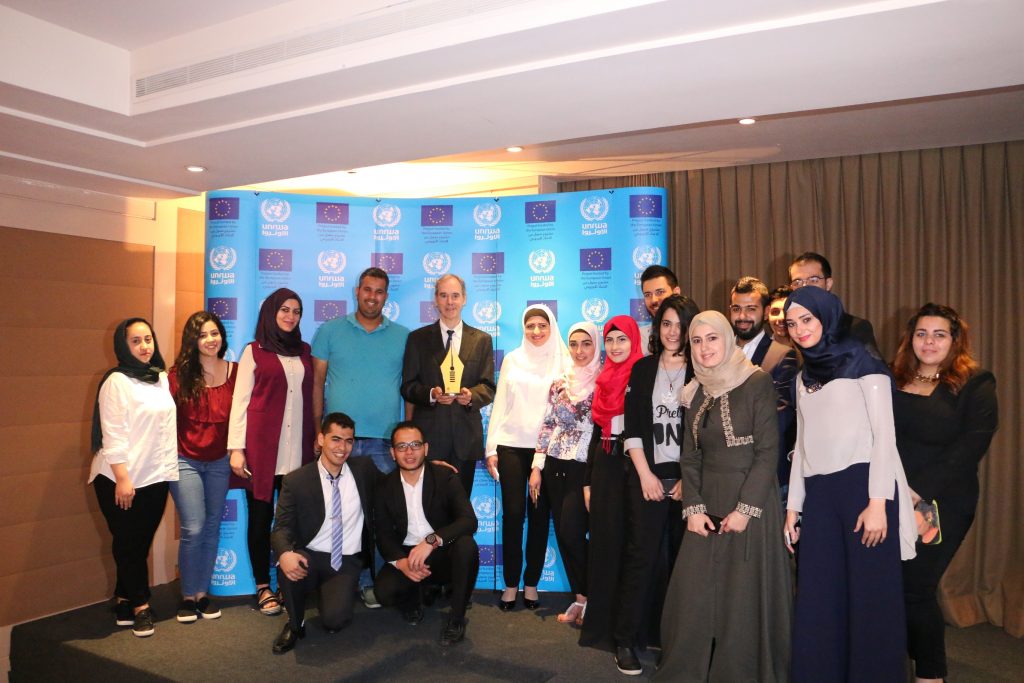
(EU/Photo)
Germany supports Palestinian Authority development
Germany focuses on supporting the development of the Palestinian Authority, in particular the establishment of an efficient Palestinian police force with good community relations. Germany supports the promotion of education and vocational training for young people, increasing employment and promoting sustainable economic development. Germany also supports good local governance and civil society development. Germany aligns development cooperation with the priorities of the Palestinian government. Since 2017, Germany has funded the Gaza Strip’s central sewage treatment plant, participated in the construction and renovation of schools and municipal infrastructure, and supported the development of improved water resources and sanitation in the Gaza Strip. In addition, Germany provides humanitarian assistance such as emergency food aid, basic medical care, psychological support and protective measures to Palestine through bilateral aid and the EU. Germany's official development assistance to Palestine is mainly implemented through the United Nations Relief and Works Agency in the East, the International Committee of the Red Cross (ICRC), the World Food Program (WFP) and the United Nations Office for the Coordination of Humanitarian Affairs.
Since the early 1980s, Germany has provided more than 1.2 billion euros in bilateral aid to Palestine. In addition, Germany actively supports multilateral agencies such as the European Union, the World Bank and the United Nations Relief and Works Agency in the East to carry out development and humanitarian projects in Palestine. In 2020, the German government provided a total of approximately 193 million euros to Palestine for development cooperation and transitional development assistance, humanitarian assistance, stability and peace building, and culture and education.
The UK protects people’s rights, increases opportunity and resilience
UK aid to Palestine works to support refugees and address humanitarian needs, protect Palestinian rights, increase economic opportunities, build Palestinian Authority capacity and strengthen accountability.
UK official development assistance mainly supports five major projects. The Refugee Project provides predictable, multi-year funding to UNRWA to support the agency’s delivery of basic education, health services, vaccines, health services and relief services to Palestine refugees and to promote regional stability. The Economic Empowerment and Development Project provides economic development assistance to Palestine in the areas of water, energy, trade and customs, promoting economic growth and inclusive employment by supporting institutional capacity and infrastructure development. Humanitarian programs provide predictable, multi-year funding to partner agencies focused on long-term needs and priority sectors, supporting increased household resilience, saving lives in humanitarian emergencies and preventing further deterioration of humanitarian situations. The Strengthening Institutions and Civil Society Capacities project provides technical assistance to the Palestinian Authority in areas such as public financial management and basic service delivery, and supports civil society organizations. The Conflict Stabilization and Security Fund plans to promote the establishment of effective and accountable Palestinian institutions, protect and assist vulnerable communities, prepare for statehood and political transition, preserve the viability of a two-state solution, uphold international humanitarian law and respond to emerging needs . In addition, the UK provides funding for development and humanitarian projects in Palestine by multilateral agencies such as the World Bank and United Nations agencies.
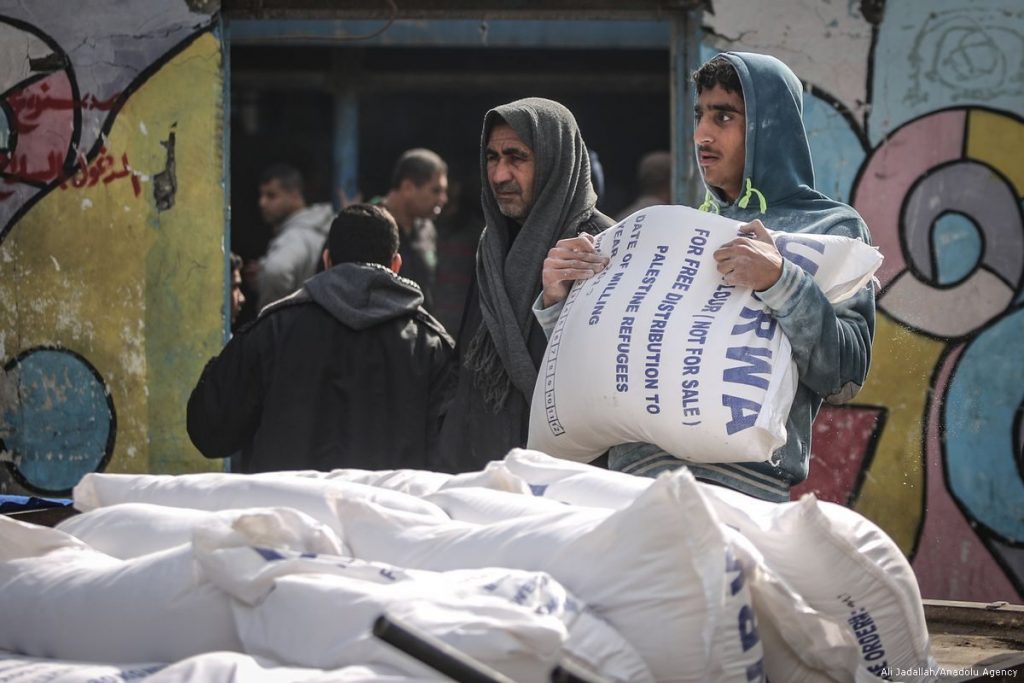
(Scott/Picture)
In the four years from the 2016-2017 fiscal year to the 2019-2020 fiscal year, the British government provided a total of approximately 477 million pounds (approximately US$615 million) in aid to Palestine. In recent years, the British government has significantly reduced its aid budget. In the 2023-2024 fiscal year and the 2024-2025 fiscal year, the UK's official development assistance budget to Palestine is 17 million pounds (approximately US$20.6 million) and 29 million pounds (approximately US$35.17 million) respectively.
Saudi Arabia provides "continued and extensive support" to Palestine
From 1994 to 2020, five Arab countries rich in oil and natural gas resources provided assistance to Palestine totaling approximately $8.5 billion. Saudi Arabia has provided official development assistance totaling approximately US$4 billion.
From 1994 to 2020, Saudi Arabia provided more than $1 billion in support to UNRWA. Saudi Arabia is providing $263 million to Palestine for the construction and renovation of Palestinian refugee camps in the West Bank and Gaza Strip, as well as the Ain Al Hilweh and Nahr Al Bared refugee camps. Saudi Arabia has also provided $107 million for UNRWA to implement the Rafah housing project, which includes the construction of 752 housing units, four schools, a health center, a cultural center, a shopping mall and a mosque, as well as the paving of roads, lights and water supply facilities.
China supports economic construction and improving people's living standards
China is committed to supporting Pakistan's economic construction and improving people's living standards. China has implemented and completed more than 40 aid construction projects in Palestine, including the Baka Refugee Primary School, Gaza Middle School, Gaza Coastal Highway, Ministry of Foreign Affairs Building, and Solar Power Station. China has donated money and materials to the United Nations Relief and Works Agency in the East and the Palestinian government on many occasions, and has Provide training for thousands of Palestinian talents in various fields to support Palestinian capacity building.
In 2012, the Chinese government provided $1 million in aid to Palestine. In 2016, President Xi Jinping announced 50 million yuan (approximately US$7.59 million) in aid to Palestine. In 2018, China provided $1 million in emergency humanitarian assistance to Palestine. In the same year, President Xi Jinping announced 100 million yuan (approximately US$15 million) in aid to Palestine. In 2019, China provided $2 million in emergency humanitarian assistance to the Palestinian government. In 2020, China donated two batches of anti-epidemic medical supplies to Palestine and dispatched an anti-epidemic medical expert team to Palestine. In 2021, China assisted Palestine with 100,000 doses of COVID-19 vaccine. In 2022, China and Egypt assisted 500,000 doses of COVID-19 vaccine with Gaza and dispatched a team of medical experts.
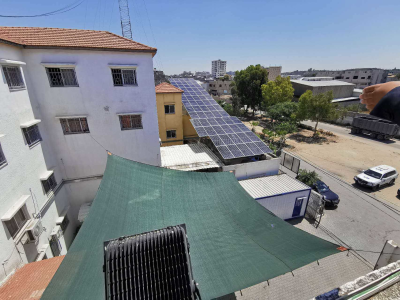
(Ministry of Foreign Affairs/Photo: China-aided solar power generation equipment for children’s hospital)
In 2018, China donated US$2.35 million to the United Nations Relief and Works Agency in the East. In 2019 and 2020, China donated US$1 million each to the United Nations Relief and Works Agency in the East and provided anti-epidemic and health material assistance. In 2021, UNRWA received a donation of US$1 million from the Chinese government.
All parties provide emergency aid to Palestine
Israel has closed crossings and stopped supplying electricity, fuel and food to Gaza amid the conflict. Egypt may be reluctant to open the crossing due to concerns about an indefinite influx of Palestinians. After days of ongoing debate and mediation, the Rafah crossing between Egypt and the Gaza Strip was opened on October 21, and the first convoy of 20 trucks carrying medical supplies and food has passed through the crossing. At the same time, two previously kidnapped American hostages were released. UN relief chief Martin Griffiths said about 100 trucks of humanitarian supplies are needed every day to meet the needs of Gaza's trapped residents.
On October 10, Denmark and Sweden announced that they would suspend the payment of development assistance to Palestine but would continue to provide humanitarian assistance. Aid to Palestine will also be thoroughly reviewed to ensure funds are not misused to indirectly support terrorist groups.
On October 10, EU and Gulf leaders held a meeting in Muscat and issued a joint statement, calling for continued assistance to Palestine and emphasizing the importance of continued support for the United Nations Relief and Works Agency in the East.
On October 14, the European Union announced that it would increase humanitarian aid to Gaza to 75 million euros (approximately 78.8 million U.S. dollars) and would cooperate with United Nations agencies and others to ensure that aid reaches those in need.
On October 16, the EU launched a humanitarian air bridge and planned to send several flights to Egypt to provide supplies, medicines and health kits provided by the United Nations Children's Fund (UNICEF) to humanitarian organizations in Gaza.
On October 16, the UK announced that it would provide an additional 10 million pounds (approximately US$12.18 million) in aid funds to support the Palestinian people.
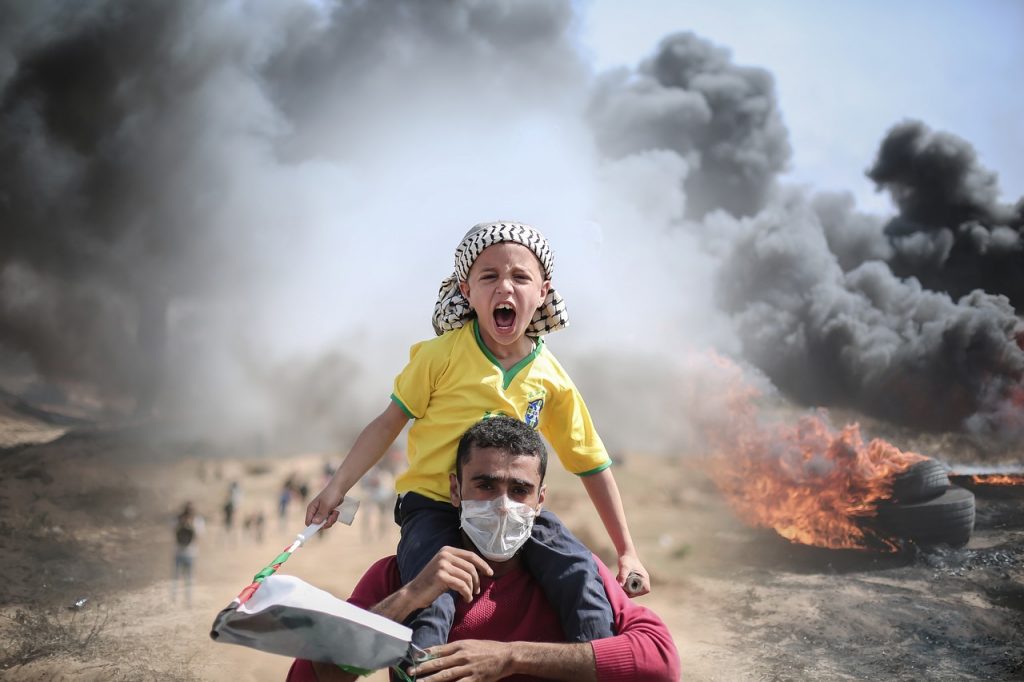
(pixabay/image)
On October 16, Saudi Arabia announced that it would donate US$2 million to the United Nations Relief and Works Agency in the East to support its response to the development and humanitarian needs of Palestinian refugees.
On October 16, the China International Development Cooperation Agency stated that China is providing emergency humanitarian assistance to the United Nations Relief and Works Agency in the East and the Palestinian National Authority respectively to solve emergency needs such as food, medical care, and housing in the Gaza Strip.
On October 18, the United States announced that it would provide $100 million in humanitarian assistance to the Palestinian people in the Gaza Strip and the West Bank, providing cleanup to more than one million displaced and conflict-affected Palestinians through UN agencies and international non-governmental organizations. water, food, hygiene support, medical care and other basic needs.
On October 20, Germany announced that it would provide 50 million euros (approximately US$52.96 million) in aid to civilians in Gaza to support international organizations such as the World Food Program and the United Nations Children's Fund, especially the United Nations Relief and Works Agency in the East. The German Foreign Ministry also expressed its readiness to send medical teams into the Gaza Strip.
References
https://news.un.org/zh/story/2021/07/1087792
https://press.un.org/en/2022/gaef3574.doc.htm
https://news.un.org/en/story/2023/05/1136662
http://ps.china-office.gov.cn/zbgx/
https://www.chinanews.com.cn/gn/2023/10-16/10094873.shtml
https://www.usaid.gov/west-bank-and-gaza/meppa
https://www.usaid.gov/west-bank-and-gaza
https://www.bbc.com/news/world-middle-east-67133675
https://www.thelocal.de/20231020/germany-pledges-e50-million-in-aid-for-gaza-civilians
https://www.timesofisrael.com/how-much-aid-does-the-us-give-palestinians-and-whats-it-for/
https://en.wikipedia.org/wiki/International_aid_to_Palestinians
https://english.aawsat.com/home/article/1283416/saudi-aid-palestine-amounts-6-billion-17-years
International Aid to the Palestinians: Between Politicization and Development
https://www.arabnews.com/node/1677736/saudi-arabia

All rights reserved. Please indicate the source when citing.
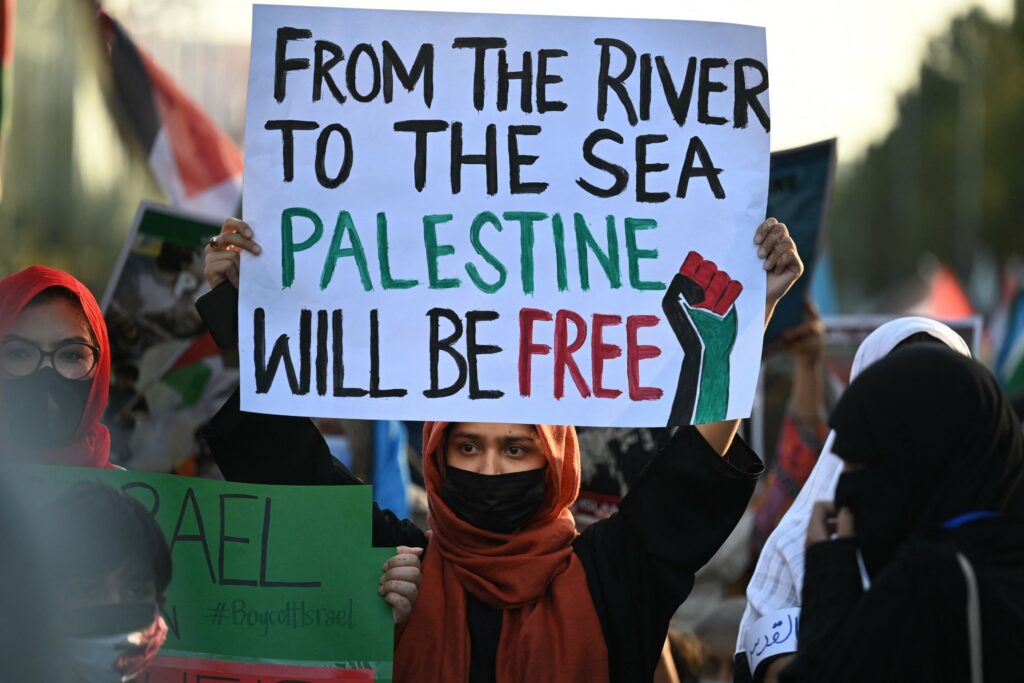
Comment (2)
gold backed ira account| February 5, 2024
This writing is a fresh view at an old issue. Thank you! I will be sharing this!
Madaline Loranger| December 21, 2024
I appreciate the detailed information shared here. Thank you for breaking down complex concepts so clearly. This blogpost answered a lot of questions I had. This post is really informative and provides great insights! The content in this blog is truly eye-opening. This blogpost answered a lot of questions I had. I can't wait to implement some of these ideas. I'm bookmarking this for future reference.